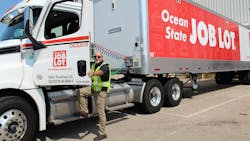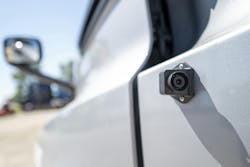Multiple months of no accidents or injuries were achieved by this fleet after revamping its safety program
New England-based retailer Ocean State Job Lot’s private fleet went from underutilizing its safety tools and having its fleet safety under the direction of its asset protection department to building a full-blown fleet safety culture and achieving zero accidents and zero injuries on the road for a full month.
The process of getting fleet safety from just part of the business to part of the culture took time, consistency, and buy-in from management. It all began when Jeff Smith, OSJL senior transportation manager, came on board in 2021 with a vision to revamp the fleet safety program to understand the root causes of accidents and learn how to prevent them entirely, he said.
“I really pushed to get us into determining root cause and us completing the investigation—rather than having our asset protection be responsible for the investigation—and developing a true transportation accident policy that encompassed all aspects of accident investigation,” Smith told FleetOwner. This included “root cause analysis and corrective counseling coming out of potential accidents to try to determine preventability—all the things that I would consider part of a complete program."
See also: New England private fleet grows through innovation and service
Building a fleet safety program
Ocean State Job Lot has 160 retail locations supported by a fleet of 55 power units, 542 dry van trailers, 86 chassis, and 74 drivers. Its drivers primarily haul from OSJL’s distribution warehouse to those 160 retail locations, but the fleet does pick up for-hire business to eliminate an empty backhaul. It also makes runs to and from the Port of Boston for for-hire drayage work.
Smith was hired to improve the fleet’s performance in all areas, but “I prioritized safety as it must be a core value, believing that safety must always come first and foremost,” he said.
Smith’s safety process began with installing dash cameras. He had firsthand experience with Trimble dash cameras with a previous employer and had them installed in all the OSJL trucks. The next step to building a safety culture was to hire a full-time transportation safety manager, leading to Frank Chauvette’s hiring in 2022. The two then got to work.
The framework
Their first objective was to build a profile for each company driver by reviewing their dash camera footage along with other safety analytics tools OSJL uses, such as ELD data, SpeedGauge, and CSA scores.
Chauvette and Smith also used the information from the videos and safety analytics tools to “come up with a definition for an accident,” Smith said, most prominently for accidents that weren’t DOT recordable. These are accidents that don’t result in a fatality or injury.
Additionally, they implemented quarterly safety meetings for the drivers to review actual footage of an incident by one of their fellow drivers (anonymously) and discuss what the driver could have done differently to prevent the incident.
See also: Data reveals a rising trend in fatal accidents involving trucks
After that, OSJL’s best drivers, referred to as Lead Driver Trainers, lead small group discussions that dig deeper into the topics discussed in the quarterly meetings. Chauvette and Smith also meet with these Lead Driver Trainers to discuss future training initiatives. In addition, OSJL also has a group of seasoned and newer drivers that make up the Driver Safety Committee that regularly meets with the management team to share driver concerns, learn how management can affect driver safety, and more.
Each of these initiatives makes up the framework of Ocean State Job Lot’s fleet safety culture.
The culture
Culture takes time to build.
Part of building a safety culture within the fleet is ensuring buy-in from drivers. For OSJL, that started with camera installation. OSJL got driver buy-in by ensuring drivers that the footage wouldn’t be used for punishment, Smith said.
“You're really pushing [drivers] to understand that this isn't something that we're trying to see what they're doing all the time,” Smith said. “It isn't that we're monitoring them. It's so that it's a protection for them, and it's a protection for the company. ... We're not big on necessarily disciplining from video. ... It's more coaching.”
Chauvette calls the coaching “hugging with words.”
“The two biggest challenges we had were speed and space,” Chauvette told FleetOwner, citing tailgating and other poor driver behaviors that spurred from prioritizing a specific pickup and delivery time instead of safety.
From there, Chauvette "hugged drivers with words” by “asking the open-ended questions,” turning the coaching into a conversation to understand the drivers’ “method to the madness,” Chauvette said.
Another aspect of building a safety culture is building a camera footage screening process that works for the fleet. Trimble doesn't prescreen footage, which is one reason OSJL prefers the Trimble system.
“Even though it's more labor on our part, the videos are not prescreened,” Smith said. “We get to see everything, and we determine what our own screening process is for what we want to present and coach to the drivers.”
As Smith said, reviewing all the footage did add more to their plate, especially in the beginning, Chauvette said.
“We wanted to be thorough, so we did have to watch every single [video triggered by the Trimble platform], upwards of almost 600-700 per week,” Chauvette explained. “However, once we got the momentum of having the drivers understand what our goals are and what we are trying to do as far as safety, the number dropped significantly. Now we're down to maybe 100 [videos] a month.”
See also: Study finds drivers’ accident recall is severely lacking, highlighting dashcam benefits
OSJL’s Zero and Zero Program
Smith and Chauvette’s goal in building the fleet safety culture isn’t to “pit blame,” Smith said. The goal is to continually improve.
“That brought us to the point where [Chauvette] and I started talking about this Zero and Zero Program,” Smith said. “How do we get to zero accidents and zero injuries?”
It boils down to risk mitigation. The two use Trimble’s video capture and analytics to identify drivers’ risky behaviors, and then they coach the drivers to mitigate those risks. Smith and Chauvette have emphasized that safety is the priority, and their drivers trust them enough to know that an on-time delivery isn’t worth making risky decisions behind the wheel.
“We all want to be efficient, we all want to deliver stuff on time, and we all want to do the right thing by our customers,” Smith said. “But we won’t compromise safety to accomplish those things. ... We’re willing to take that hit; we’re willing to reschedule a pickup if that’s what we need to do.”
The trust from the drivers didn’t come by chance—it was built, and buy-in from leadership and management was required to build it.
“[Smith] and I were very fortunate to have people above us who believed in what we were doing regarding safety,” Chauvette explained. “So, everyone knew it came from up top; that this was something that is critical for us being safe every single day.”
In fact, Smith said the company’s leadership has never pushed back on his and Chauvette’s methods or messaging to improve the safety program.
In addition to leadership buy-in, consistency—or “living it,” as Smith says—is also key.
“When you tell your dispatchers, your managers, your clerks—I mean everybody—that we don't compromise safety, and you demonstrate it—‘No, you're not going to get in trouble because you missed the pickup. No, we're not going to yell at you because you were doing 55 instead of 35’—all those things come out as demonstration to the driver pool that you really are living it. You believe in it,” Smith said.
Further, being consistent means the rules are the rules, no matter the circumstance.
“You can't be safe today and then do something that goes against safety tomorrow because it's convenient for operations or it's more important to operations,” Smith explained.
Upon launching the Zero and Zero Program, OSJL offered swag to its drivers, including T-shirts and coffee mugs with the Zero and Zero logo on them, in order to encourage drivers to remain safe and to give the new program momentum.
Since the program was launched in 2023, it has achieved an entire month of zero accidents and zero injuries three separate times.
About the Author
Jade Brasher
Senior Editor Jade Brasher has covered vocational trucking and fleets since 2018. A graduate of The University of Alabama with a degree in journalism, Jade enjoys telling stories about the people behind the wheel and the intricate processes of the ever-evolving trucking industry.



